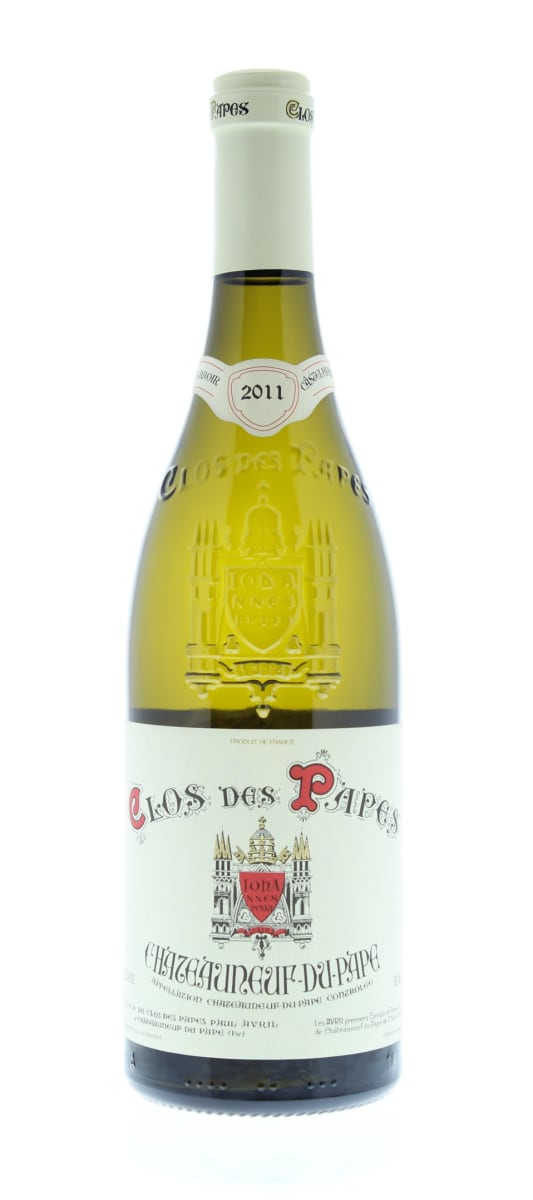Clos des Papes Chateauneuf-du-Pape Blanc 2011
-
Wine
Spectator -
Robert
Parker




Product Details
Your Rating
Somm Note
Winemaker Notes
Professional Ratings
-
Wine Spectator
A bracing, pure style with a tightly coiled score of talc, honeysuckle , kaffir lime and white peach notes. Sleek and racy, with a stony accent inlaid on the finish, adding extra detail and range. Shows the latent depth and the purity to develop steadily in the cellar. Drink now through 2021.
-
Robert Parker's Wine Advocate
The 2011 Chateauneuf du Pape Blanc is composed of all the white varietals permitted in Chateauneuf du Pape. Although it is not put through malolactic fermentation and sees no oak whatsoever, this cuvee has proven to age remarkably well. The 2011 exhibits lots of poached pear, honeysuckle, quince and white currants as well as a full-bodied, powerful (15.6% natural alcohol) style. It reveals lots of glycerin along with wonderful freshness, acidity and purity. The 2011 should last for 10-12 years.
Other Vintages
2022-
Jeb
Dunnuck -
Wine
Spectator -
Robert
Parker - Vinous
-
James
Suckling
-
Jeb
Dunnuck -
Robert
Parker - Vinous
-
James
Suckling
-
Wine
Spectator -
Jeb
Dunnuck -
Robert
Parker
-
Wine
Spectator -
Robert
Parker
-
James
Suckling
-
Wine
Spectator -
Robert
Parker
-
Robert
Parker -
Wine
Spectator
-
Robert
Parker -
Wine
Spectator


There are no fewer than 24 different plots of land, which include some of the most beautiful soils in the Chateauneuf vineyards. The geographical separation of our vineyards enables us to control ripeness at harvest time, since each sector does not necessarily reach the exact same stage at the same time. It also allows us to combine different varieties planted to the south. "Clos des Papes makes both red wines and white wines (10% of the production) for long-keeping, using traditional vinification and maturing. As I mentioned previously, our yields are deliberately low (an average of 28hl/hectare). and then undergo further strict sorting, to uphold our quality.

Full-bodied and flavorful, white Rhône blends originate from France’s Rhône Valley. Today these blends are also becoming popular in other regions. Typically some combination of Grenache Blanc, Marsanne, Roussanne and Viognier form the basis of a white Rhône blend with varying degrees of flexibility depending on the exact appellation. Somm Secret—In the Northern Rhône, blends of Marsanne and Roussanne are common but the south retains more variety. Marsanne, Roussanne as well as Bourboulenc, Clairette, Picpoul and Ugni Blanc are typical.

Famous for its full-bodied, seductive and spicy reds with flavor and aroma characteristics reminiscent of black cherry, baked raspberry, garrigue, olive tapenade, lavender and baking spice, Châteauneuf-du-Pape is the leading sub-appellation of the southern Rhône River Valley. Large pebbles resembling river rocks, called "galets" in French, dominate most of the terrain. The stones hold heat and reflect it back up to the low-lying gobelet-trained vines. Though the galets are typical, they are not prominent in every vineyard. Chateau Rayas is the most obvious deviation with very sandy soil.
According to law, eighteen grape varieties are allowed in Châteauneuf-du-Pape and most wines are blends of some mix of these. For reds, Grenache is the star player with Mourvedre and Syrah coming typically second. Others used include Cinsault, Counoise and occasionally Muscardin, Vaccarèse, Picquepoul Noir and Terret Noir.
Only about 6-7% of wine from Châteauneuf-du-Pape is white wine. Blends and single-varietal bottlings are typically based on the soft and floral Grenache Blanc but Clairette, Bourboulenc and Roussanne are grown with some significance.
The wine of Chateauneuf-du-Pape takes its name from the relocation of the papal court to Avignon. The lore says that after moving in 1309, Pope Clément V (after whom Chateau Pape-Clément in Pessac-Léognan is named) ordered that vines were planted. But it was actually his successor, John XXII, who established the vineyards. The name however, Chateauneuf-du-Pape, translated as "the pope's new castle," didn’t really stick until the 19th century.
